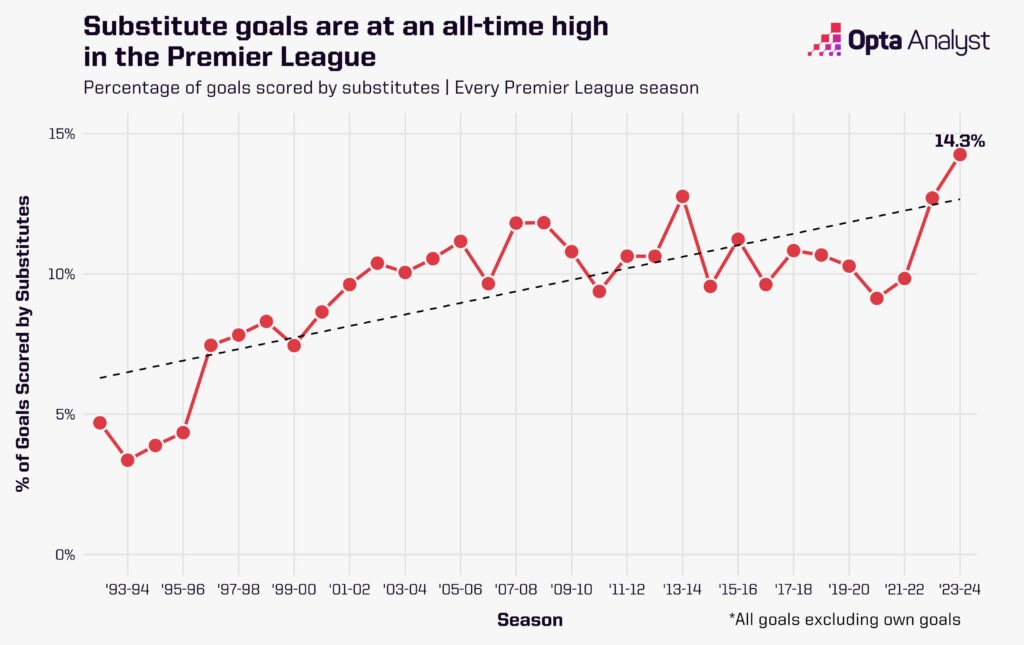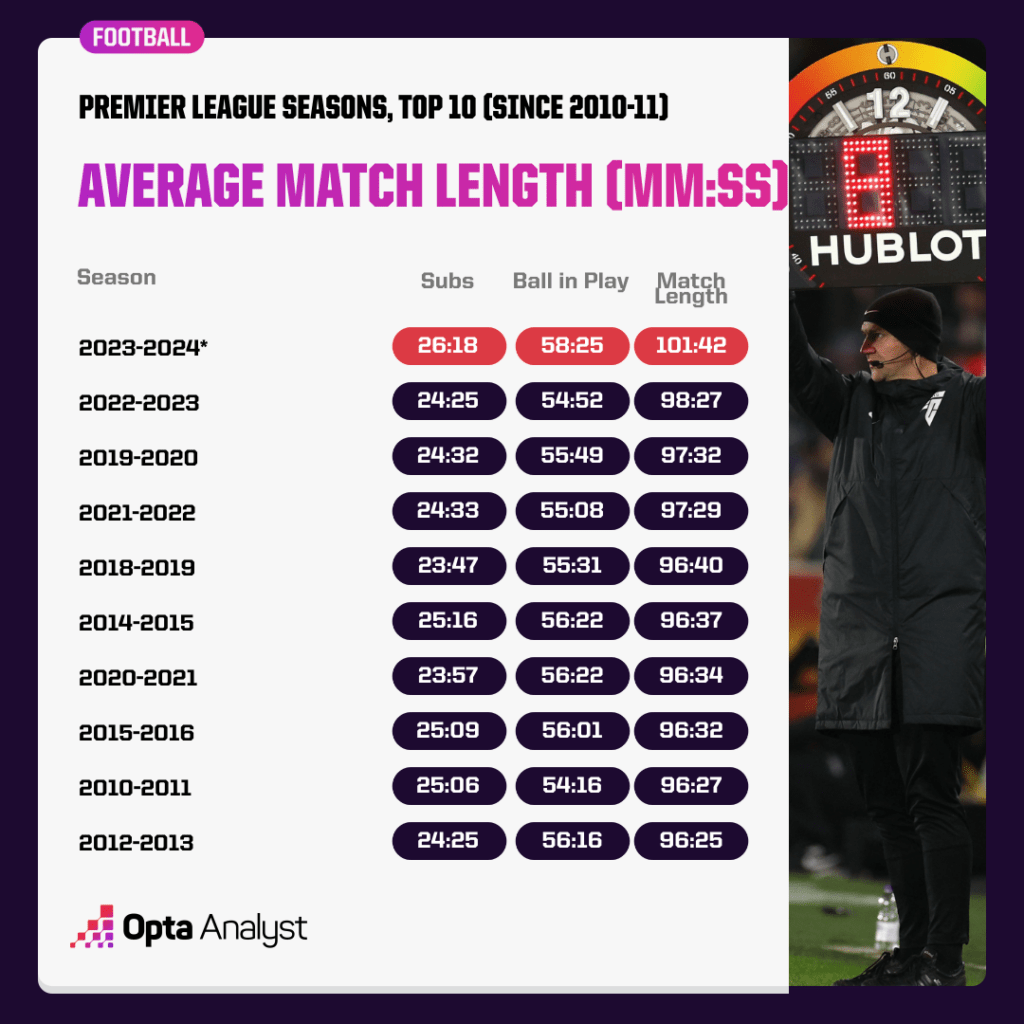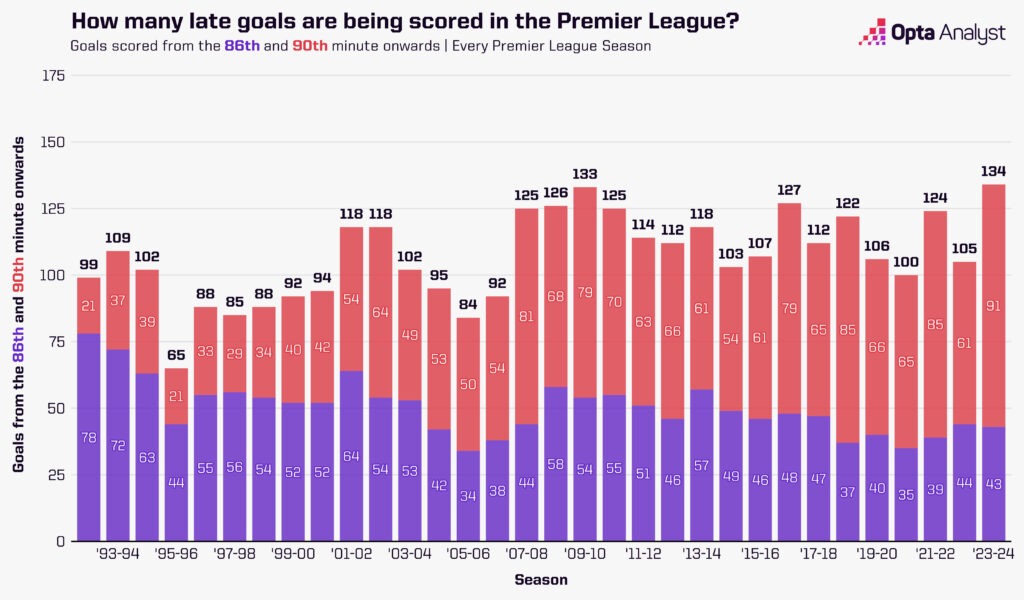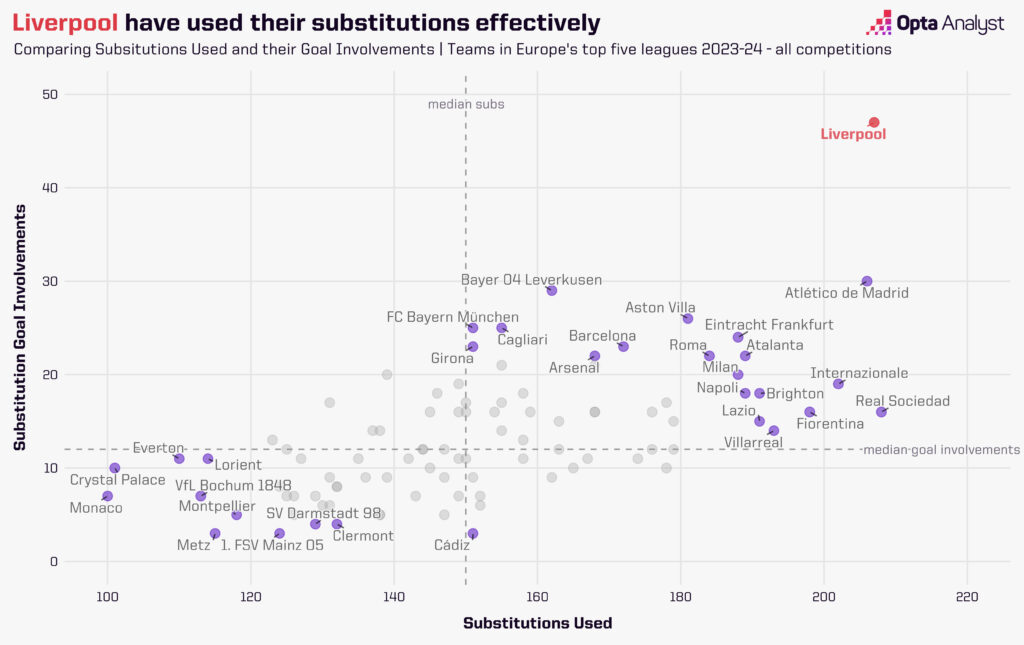Changes to the laws of the game combined with new approaches to refereeing matches have seen Premier League substitutes take on even greater significance. We look at just how important substitutes have become in the Premier League.
Football is an ever-changing beast. While on the surface it might look the same as it’s always been with 22 players kicking a sack of air around, just including different names and faces, regular changes to the laws of the game ensures it continues to evolve.
There are many examples. There was the introduction of yellow and red cards at the 1970 World Cup; the backpass rule coming into being in 1992; and substitutions were only officially allowed as of 1958.
In fact, the landscape around substitutions has developed significantly through the years. It was as recently as 1995 when the number of subs a team could make in a game was increased to three; prior to 1967-68, substitutions in England could only be made to replace injured players; while Mexico 1970 was the first World Cup to include tactical subs (a maximum of two).
But since the mid-90s, we’ve seen the number of players named on benches in the Premier League increase from five, to seven, to nine now, while teams can use five of those subs in a given game, as long as they aren’t made in more than three in-game windows (excluding half-time).
It’s impossible to ignore the benefits to aspects like player welfare since substitutions were initially brought it. Scenarios like Bert Trautmann playing on in goal during the 1956 FA Cup final despite breaking his neck have been thankfully consigned to history.
The concussion substitute has also arrived in top-level football after campaigners spent years pleading for more rigorous control around managing risks related to head injuries because of links to serious neurological disorders. The first concussion substitute in English football was made in a February 2021 FA Cup game between Manchester United and West Ham, with Issa Diop the one to be withdrawn.
Substitutes are more commonly used for tactical purposes or to introduce “fresh legs” now, however, with reinforcements potentially to the tune of five players enabling managers to change 50% of their starting outfield players if they so wish.
As such, over the past 18 months or so, we’ve seen substitutions made at a rate unlike ever before.
In 2023-24, we are seeing an average of 7.9 substitutes per match in the Premier League. While that’s an identical record to 2022-23, it’s obviously a huge increase on what came before.
The 2019-20 campaign previously held the record for most subs made per match on average with 5.9; considering teams could only use three each in a given game then, that highlights how managers used their full complement more often than not.
Although that was the most extreme example of substitution use prior to last season, attitudes around subs were generally pretty similar from 2012-13 until 2021-22, with each campaign averaging at least 5.4 per match.
But between 2012-13 and the turn of the century, there was quite a lot of change – if you’ll excuse the pun. During the 1999-00 season, games averaged just 4.2 subs; in 2009-10 (5.2), this figure went above 5.0 for a single campaign for the first time.
Games seeing more substitutions now than 24 years ago isn’t particularly revelatory or anything, though. It’s obviously because the laws have been altered, so it’s to be expected. However, the increase in available subs is having a profound impact.
With 283 matches played in the English top flight this season, 126 goals have been scored by subs. That’s already just six behind the total for last season, with 132 the record for a single Premier League campaign.
But what puts the new-found importance of subs into the most useful context is that those 126 goals are 14.3% of the league-wide total of 884, with the proportion of goals scored (excluding own goals) by substitutes this term currently on track to comfortably set a new record.

The thing is, you may well be assuming that the 2022-23 season holds the record for that at the moment, considering it was the first to allow up to five substitutions, but you’d be wrong. In 2013-14, 12.8% of Premier League goals were scored by subs, whereas 12.7% were in 2022-23. So, what’s specifically changed this season?
Well, new refereeing directives introduced at the start of 2023-24 included clamping down on time wasting, and referees were instructed to make stoppage time more reflective of the actual time lost to in-game delays.
Concerns had previously been raised about how much time was lost in matches, meaning fans were essentially not getting the best value for money. But as a result of the new directives, match time has increased because more stoppage time is being added, while ball-in-play time is also up.
This season, the Premier League’s average match length is at 101 minutes and 42 seconds; that’s easily the longest on record (since 2010-11 officially, though it’s unlikely to have been any higher before 2010-11), with games lasting at least three minutes longer than any previous campaign (98:27 in 2022-23).
This is also reflected by the ball-in-play time of 58:25; last term it was 54:52, while the most it had been over the past 14 years was 56:44 in 2013-14.
We can even break this data right down to see how it’s impacted substitutes alone; the findings are significant and provide further clarity to why they’re impacting the game more than ever.

The average time – including stoppage time – played by subs this season is 26:18, which is also the longest on record (since 2010-11) in the Premier League. The previous high was 25:38 from 2013-14; as mentioned before, that campaign had also seen the highest proportion of goals scored by subs before this one, thus highlighting something of a correlation.
So, not only are more substitutes allowed, they also have more real time than ever to make a difference, meaning the landscape of the game has been changing before our very eyes.
Another tangible consequence of more subs combined with more time is the amount of late goals being scored. That’s not to say substitutes are necessarily scoring or assisting all or the majority of these late goals, but players are more likely to be brought off the bench in the second half, so it’s logical to attach some significance to the increase in those scored in the final minutes.
And there’s definitely been an increase here. The 2023-24 season has already seen more goals scored in or after the 86th minute of matches (134) than any previous Premier League campaign, with 133 (2009-10) the previous most.
Ninety-one of those 134 have come in the 90th minute of matches or later, which is six more than any previous Premier League season (85 in 2018-19 and 2021-22) has seen.

Liverpool have made the best use of subs in the Premier League this term, with players who’ve come off the bench tallying 22 goal involvements for them in the league. That’s four more than any other team in 2023-24 and just two shy of the record, which was set by Manchester City in 2011-12.
Their output also extends beyond the Premier League. In all competitions, Liverpool substitutes have amassed 47 goal involvements, 17 more than any other team from the top five leagues (Atlético Madrid), and 15 more than any other English club (Southampton).
But the Reds aren’t the only team with an outstanding record. In Premier League history, there have been 23 instances of a team tallying 17 or more goal involvements through substitutes in a single campaign; four of them (Liverpool – 22, Arsenal – 18, Newcastle – 18, Aston Villa – 17) have occurred this term, with no other campaign having more than two entries. Brighton (16) and Fulham (14) could yet climb into the reckoning before the end of the season.

It’s easy to make bold claims about present-day things being the best or better than what came before, but there’s no need for recency bias here; the numbers tell the story of how the role of the substitute has been transformed.
Law changes in football aren’t always for the best; VAR remains a constant source of debate, confusion and frustration, for example. But alterations to the rules around substitutes and the directives around time keeping have demonstrably made the game better, more entertaining and more unpredictable.
Games are longer, the ball’s in play more, and the influence of substitutes has never been greater as they directly influence the excitement towards the ends of games.
In terms of in-match impact, substitutes are more important than ever before, but this is hopefully just the beginning.
Enjoy this? Subscribe to our football newsletter to receive exclusive weekly content. You should also follow our social accounts over on X, Instagram, TikTok and Facebook.
